
The history of Armenia covers the topics related to the history of the Republic of Armenia, as well as the Armenian people, the Armenian language, and the regions of Eurasia historically and geographically considered Armenian.
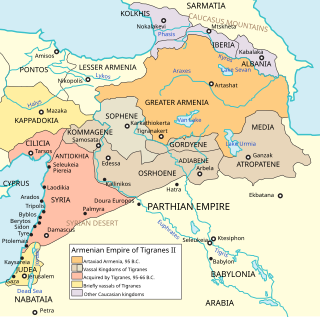
Armenia, also the Kingdom of Greater Armenia, or simply Greater Armenia or Armenia Major sometimes referred to as the Armenian Empire, was a kingdom in the Ancient Near East which existed from 331 BC to 428 AD. Its history is divided into the successive reigns of three royal dynasties: Orontid, Artaxiad and Arsacid (52–428).
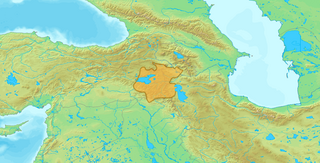
The Artsrunis were an ancient princely and, later, royal dynasty of Armenia.
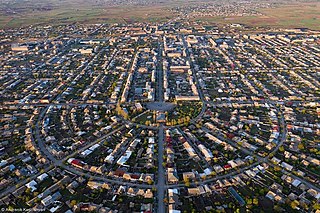
Armavir, is a town and urban municipal community located in the west of Armenia serving as the administrative centre of Armavir Province. It was founded in 1931 by the government of the Armenian Soviet Socialist Republic. As of the 2011 census, the population of the town is 29,319, down from 46,900 as reported in the 1989 census. Currently, the town has a population of 65,515 as per the 2023 official estimate.

Sophene was a province of the ancient kingdom of Armenia, located in the south-west of the kingdom, and of the Roman Empire. The region lies in what is now southeastern Turkey.
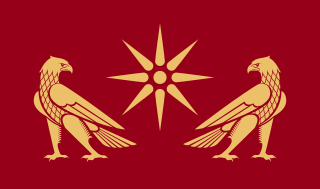
The Artaxiad dynasty ruled the Kingdom of Armenia from 189 BC until their overthrow by the Romans in 12 AD. Their realm included Greater Armenia, Sophene and, intermittently, parts of Mesopotamia. Their main enemies were the Romans, the Seleucids and the Parthians, against whom the Armenians conducted multiple wars. Under the Artaxiad king Tigranes the Great, the Kingdom of Armenia reached its greatest territorial extent, extending for a brief period from the Caspian to the Mediterranean Sea.
The Orontid dynasty, also known as the Eruandids or Eruandunis, ruled the Satrapy of Armenia until 330 BC and the Kingdom of Armenia from 321 BC to 200 BC. The Orontids ruled first as client kings or satraps of the Achaemenid Empire and after the collapse of the Achaemenid Empire established an independent kingdom. Later, a branch of the Orontids ruled as kings of Sophene and Commagene. They are the first of the three royal dynasties that successively ruled the antiquity-era Kingdom of Armenia.
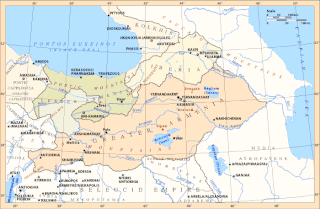
The Satrapy of Armenia, a region controlled by the Orontid dynasty, was one of the satrapies of the Achaemenid Empire in the 6th century BC that later became an independent kingdom. Its capitals were Tushpa and later Erebuni.
The early military history of Armenia is defined by the situation of the Armenian Highland between the Hellenistic states, and later the Byzantine Empire, in the west and the Persian Empire to the east. The Kingdom of Armenia had a series of repeated struggles against Persia or Rome, followed by renewed conquests into either of the neighboring empires. The period after the Muslim conquests in the 7th century, up to the late 15th century, was mostly marked by invasions by other empires, such as by the successive Arab Caliphates, the Seljuk Empire, the Ilkhanate, the Timurid Empire and the Ak Koyunlu and Kara Koyunlu, amongst others. Some periods of greater military independence were, intermittently, achieved under the Bagratids and, albeit located outside the Armenian Highlands, the Armenian Kingdom of Cilicia.
The origin of the Armenians is a topic concerned with the emergence of the Armenian people and the country called Armenia. The earliest universally accepted reference to the people and the country dates back to the 6th century BC Behistun Inscription, followed by several Greek fragments and books. The earliest known reference to a geopolitical entity where Armenians originated from is dated to the 13th century BC as Uruatri in Old Assyrian. Historians and Armenologists have speculated about the earlier origin of the Armenian people, but no consensus has been achieved as of yet. Genetic studies show that Armenian people are indigenous to historical Armenia, showing little to no signs of admixture since around the 13th century BC.
The name Armenia entered English via Latin, from Ancient Greek Ἀρμενία.

Tushpa was the 9th-century BC capital of Urartu, later becoming known as Van which is derived from Biainili, the native name of Urartu. The ancient ruins are located just west of Van and east of Lake Van in the Van Province of Turkey. In 2016 it was inscribed in the Tentative list of World Heritage Sites in Turkey.
Shubria or Shupria was a kingdom in the southern Armenian highlands, known from Assyrian sources in the first half of the 1st millennium BC. It was located north of the upper Tigris River and to the southwest of Lake Van, extending eastwards to the frontiers of Urartu. It appears in the 1st millennium BC as an independent kingdom, succeeding the people earlier called Shubaru in Assyrian sources in the later centuries of the 2nd millennium BC. It was located between the powerful states of Assyria and Urartu and came into conflict with both. It was conquered by Assyria in 673–672 BC but likely regained its independence towards the end of the 7th century BC with the collapse of Assyrian power.

The History of Armenia, attributed to Movses Khorenatsi, is an early account of Armenia, covering the legendary origins of the Armenian people as well as Armenia's interaction with Sassanid, Byzantine and Arsacid empires down to the 5th century.

Tigranes was a legendary Armenian prince, who was a contemporary of the Achaemenid ruler Cyrus the Great.

Armavir is a village in the Armavir Province of Armenia near the Armenia–Turkey border. Cuneiform inscriptions of Urartian King Sarduri II were found at Armavir.
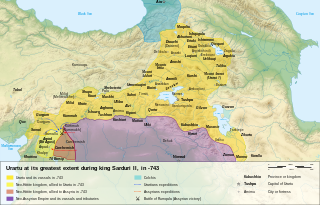
Urartu was an Iron Age kingdom centered around Lake Van in the Armenian Highlands. It extended from the eastern bank of the upper Euphrates River to the western shores of Lake Urmia and from the mountains of northern Iraq to the Lesser Caucasus Mountains. Its kings left behind cuneiform inscriptions in the Urartian language, a member of the Hurro-Urartian language family. Since its re-discovery in the 19th century, Urartu, which is commonly believed to have been at least partially Armenian-speaking, has played a significant role in Armenian nationalism.

Orontes I Sakavakyats was a legendary king of Armenia, who was the personification of the Orontid dynasty.

Armavir was a large commercial city and the capital of ancient Armenia during the reign of the Orontid dynasty. It is located 1 km west of the 17th-century village of Armavir.

Yervandashat or Eruandashat was an Armenian city and one of the historical capitals of Armenia, serving as the capital city between c. 200 BC and 176 BC under the rule of the Orontid dynasty and at the beginning of the rule of their successors, the Artaxiad dynasty. Its ruins are located on a rocky hill near the confluence of the Akhuryan and Aras rivers, on the left bank of the Aras, between the villages of Yervandashat and Bagaran in modern-day Armenia.















